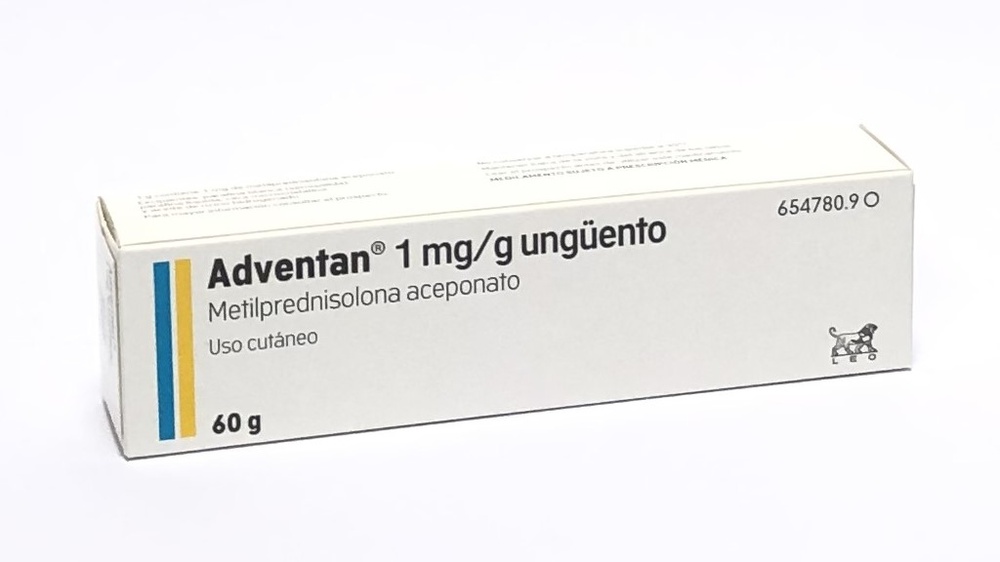

ADVENTAN 1 mg/g OINTMENT

Ask a doctor about a prescription for ADVENTAN 1 mg/g OINTMENT

How to use ADVENTAN 1 mg/g OINTMENT
Introduction
Package Leaflet: Information for the User
Adventan 1mg/g ointment
Methylprednisolone aceponate
Read all of this leaflet carefully before you start using this medicine because it contains important information for you.
- Keep this leaflet, you may need to read it again.
- If you have any further questions, ask your doctor or pharmacist.
- This medicine has been prescribed for you only. Do not pass it on to others. It may harm them, even if their signs of illness are the same as yours.
- If you get any side effects, talk to your doctor or pharmacist. This includes any possible side effects not listed in this leaflet. See section 4.
Contents of the pack
- What Adventan ointment is and what it is used for
- What you need to know before you use Adventan ointment
- How to use Adventan ointment
- Possible side effects
- Storing Adventan ointment
- Contents of the pack and other information
1. What Adventan ointment is and what it is used for
It is an anti-inflammatory medicine (a corticosteroid) for use on the skin.
Adventan ointment reduces inflammation and allergic reactions of the skin, and reactions associated with excessive cell multiplication (hyperproliferation). Therefore, it reduces redness (erythema), fluid accumulation (edema), and exudate on inflamed skin. It also relieves itching, burning, or pain.
Adventan ointment is used in the treatment:
? Acute eczema of mild to moderate severity related to an external cause, such as:
- Allergy to a substance that has come into contact with the skin (allergic contact dermatitis).
- Allergic reaction to substances of habitual use, such as soap (irritant contact dermatitis).
- Coin-shaped eruption (nummular eczema).
- Itchy eruption on hands and feet (dyshidrotic eczema).
- Unspecified eczema (atopic eczema).
- Eczema related to patient factors (endogenous eczema), such as atopic dermatitis or neurodermatitis.
- Skin eruption with inflammation and scaling (seborrheic eczema).
This form, in ointment, is particularly indicated in very dry conditions.
2. What you need to know before you use Adventan ointment
Do not use Adventan ointment
- If you are allergic to methylprednisolone aceponate (MPA) or any of the other ingredients of this medicine (listed in section 6).
- If you have tuberculosis, syphilis, or viral infections (such as chickenpox or herpes).
- If you have rosacea (a condition that causes inflammation of the skin, red/pink in color), ulcers, acne, or skin diseases with skin thinning (atrophy).
- In areas of the skin that show a vaccination reaction, i.e., redness or inflammation after vaccination.
- In inflammation specific to the skin around the upper lip and chin (perioral dermatitis).
- In case of bacterial or fungal infections, see "Warnings and precautions" section.
- It must not be used in the eyes or on open wounds.
- Not to be used in children under four months of age due to lack of safety data.
Warnings and precautions
Consult your doctor or pharmacist before starting to use Adventan ointment.
If your doctor diagnoses a bacterial or fungal infection, you should also use the additional treatment prescribed for the infection, because if you do not, the infection may worsen.
Contact your doctor if you experience blurred vision or other visual disturbances.
Anti-inflammatory drugs (corticosteroids), such as the active ingredient MPA of Adventan, have significant effects on the body. It is not recommended to use Adventan on large areas of the skin or for prolonged periods, as this significantly increases the risk of side effects.
To reduce the risk of side effects:
- Use it at the lowest possible dose, especially in children.
- Use it only for the time strictly necessary to relieve the skin condition.
- Adventan ointment must not come into contact with the eyes, mouth, open wounds, or mucous membranes (e.g., anal or genital area).
- It must not be used in skin folds, groin, or armpits.
- It must not be used under impermeable materials to air and water, including bandages (unless your doctor indicates otherwise), dressings, clothing, or diapers that are not very breathable.
If you use Adventan for diseases other than those for which it has been prescribed, it may mask symptoms and make it difficult to diagnose and treat correctly.
If you apply Adventan ointment to the anal or genital area, some of its ingredients may damage latex products such as condoms or diaphragms. Therefore, they may no longer be effective as contraceptives or as protection against sexually transmitted diseases, such as HIV infection. Consult your doctor or pharmacist if you need more information.
Children
It is essential to consider that diapers can be occlusive. If the doctor weighs the benefits and risks beforehand, Adventan ointment may be prescribed for use in children between 4 months and 3 years of age.
Using Adventan ointment with other medicines
Tell your doctor or pharmacist if you are using, have recently used, or might use any other medicines.
No interactions of Adventan ointment with other medicines are known at present.
Pregnancy, breastfeeding, and fertility
If you are pregnant or breastfeeding, think you may be pregnant, or are planning to have a baby, ask your doctor or pharmacist for advice before using this medicine.
To avoid any risk to the baby, do not use Adventan ointment if you are pregnant or breastfeeding, unless your doctor advises you to.
If your doctor recommends using Adventan ointment during breastfeeding, do not apply the medicine to the breasts; do not let the baby come into contact with treated areas.
Driving and using machines
This medicine does not affect your ability to drive or use machines.
Adventan ointment contains hydrogenated ricin oil
This medicine may cause skin reactions because it contains hydrogenated ricin oil.
3. How to use Adventan ointment
Follow exactly the instructions for this medicine given by your doctor.
In case of doubt, consult your doctor or pharmacist again.
Unless your doctor tells you otherwise, the recommended dose is:
Topical use
- Apply Adventan ointment in a thin layer, once a day, to the affected area, rubbing gently.
- Generally, the duration of treatment should not exceed 12 weeks. Always make the treatment as short as possible.
- Intermittent treatment is recommended when prolonged treatment is needed.
- If you use Adventan for a skin eruption with inflammation and scaling (seborrheic eczema) of the face, do not treat the affected areas for more than one week.
Use in children
Adventan ointment should not be used in children under four months of age due to lack of safety data.
The duration of treatment in children should be limited to the minimum, generally not exceeding 4 weeks.
If you use more Adventan ointment than you should
No risk of acute intoxication is expected after a single topical application of an overdose (application to a large area, under favorable conditions for absorption) or after accidental ingestion.
In case of overdose or accidental ingestion, consult your doctor or pharmacist immediately or go to a medical center, or call the Toxicology Information Service, phone 91 562 04 20 (indicating the medicine and the amount ingested).
If you forget to use Adventan ointment
Do not use a double dose to make up for forgotten doses. If you have forgotten a dose, continue with your usual schedule as instructed by your doctor or as described in this leaflet.
If you stop using Adventan ointment
If you stop treatment prematurely, the original symptoms of your skin problem may recur. Please contact your doctor before stopping treatment with Adventan ointment.
If you have any further questions on the use of this medicine, ask your doctor or pharmacist.
4. Possible side effects
Like all medicines, this medicine can cause side effects, although not everybody gets them.
The assessment of side effects is based on the following frequencies:
Very common: may affect more than 1 in 10 people
Common: may affect up to 1 in 10 people
Uncommon: may affect up to 1 in 100 people
Rare: may affect up to 1 in 1,000 people
Very rare: may affect up to 1 in 10,000 people.
Frequency not known (cannot be estimated from the available data).
- Common
Burning at the application site and inflammation of hair follicles (folliculitis).
- Uncommon
Dilated small blood vessels in the skin (telangiectasias), skin cracks, itching, pain, blisters (vesicles), and pimples (pustules) at the application site.
- Frequency not known
Hypersensitivity to the active substance.
Acne, skin thinning (atrophy), skin stretch marks, inflammation specific to the skin around the upper lip and chin (perioral dermatitis), skin discoloration, and allergic skin reactions.
Increased hair growth (hypertrichosis).
Blurred vision.
Side effects may occur not only in the treated area but also in completely different parts of the body. This happens if the active substance (a corticosteroid) passes into the body through the skin. This, for example, can increase pressure in the eye (glaucoma).
Reporting of side effects
If you experience any side effects, talk to your doctor or pharmacist, even if they are not listed in this leaflet. You can also report side effects directly to the Spanish Medicines and Health Products Agency (AEMPS) via their website: www.notificaram.es.
By reporting side effects, you can help provide more information on the safety of this medicine.
5. Storing Adventan 1 mg/g ointment
Do not store above 30°C.
Keep this medicine out of the sight and reach of children.
Do not use this medicine after the expiry date which is stated on the carton, after EXP. The expiry date refers to the last day of the month stated.
Medicines should not be disposed of via wastewater or household waste. Ask your pharmacist how to dispose of medicines no longer required. These measures will help protect the environment.
6. Contents of the pack and other information
Composition of Adventan ointment
- The active substance is Methylprednisolone aceponate (MPA). Each gram of ointment contains 1 mg of methylprednisolone aceponate (0.1%).
- The other ingredients (excipients) are: white soft paraffin, liquid paraffin, microcrystalline wax, hydrogenated ricin oil.
Appearance and pack size
Adventan ointment is a translucent, white to slightly yellowish ointment and is available in tubes of 30 and 60 g.
Not all pack sizes may be marketed.
Marketing authorisation holder and manufacturer
Marketing authorisation holder:
LEO Pharma A/S
Industriparken 55
DK-2750 Ballerup
Denmark
Manufacturer:
LEO Pharma Manufacturing Italy S.r.l.
Via E. Schering, 21
20054 Segrate (Milan) - Italy
Date of last revision of this leaflet: January 2020
Detailed and updated information on this medicine is available on the website of the Spanish Agency for Medicines and Health Products (AEMPS) http://www.aemps.gob.es.

How much does ADVENTAN 1 mg/g OINTMENT cost in Spain ( 2025)?
The average price of ADVENTAN 1 mg/g OINTMENT in December, 2025 is around 5.23 EUR. Prices may vary depending on the region, pharmacy, and whether a prescription is required. Always check with a local pharmacy or online source for the most accurate information.
- Country of registration
- Average pharmacy price5.23 EUR
- Active substance
- Prescription requiredYes
- Manufacturer
- This information is for reference only and does not constitute medical advice. Always consult a licensed doctor before taking any medication. Oladoctor is not responsible for medical decisions based on this content.
- Alternatives to ADVENTAN 1 mg/g OINTMENTDosage form: CREAM, 1 mg/gActive substance: methylprednisolone aceponateManufacturer: Leo Pharma A/SPrescription requiredDosage form: EMULSION, 1 mg/gActive substance: methylprednisolone aceponateManufacturer: Leo Pharma A/SPrescription requiredDosage form: OINTMENT, 1 mg/gActive substance: methylprednisolone aceponateManufacturer: Leo Pharma A/SPrescription required
Alternatives to ADVENTAN 1 mg/g OINTMENT in other countries
The best alternatives with the same active ingredient and therapeutic effect.
Alternative to ADVENTAN 1 mg/g OINTMENT in Poland
Alternative to ADVENTAN 1 mg/g OINTMENT in Ukraine
Online doctors for ADVENTAN 1 mg/g OINTMENT
Discuss dosage, side effects, interactions, contraindications, and prescription renewal for ADVENTAN 1 mg/g OINTMENT – subject to medical assessment and local rules.







